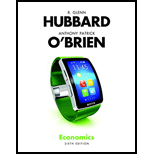
The relationship between the current account, financial account and balance of payment.
Explanation of Solution
The financial account and current account are the components of the balance of the payment. The sum of the current account and financial account is equal to the balance of the payment, which should be zero to each other that is, if the current account has a deficit balance, the financial account should have a surplus balance.
Concept Introduction:
Current account: The current account is the entry of all the transactions of a country net export, net income on investment and net transfers as a part of the balance of payment.
Financial account: The financial account is the book keeping entry of all the transactions such as the purchases of the goods and services from the foreign country.
Balance of payment: The balance of the payment is the book keeping entry of the trade between two countries goods and services.
Want to see more full solutions like this?
Chapter 29 Solutions
Economics Plus MyLab Economics with Pearson eText (2-semester Access) -- Access Card Package (6th Edition) (The Pearson Series in Economics)
- Use the Feynman technique throughout. Assume that you’re explaining the answer to someone who doesn’t know the topic at all: 15. How is the Keynesian expenditure multiplier implicit in the Keynesian version of the AD/ASmodel? Explain and show mathematically. (note: this is a tough one)arrow_forwardUse the Feynman technique throughout. Assume that you’re explaining the answer to someone who doesn’t know the topic at all: 13. What would happen to the net exports function in Europe and the US respectively if thedemand for dollars rises worldwide? Explain why.arrow_forward20. Given the mathematical model below, solve for the expenditure multiplier for a) government spending, G; and b) for consumer taxes, T. (medium difficulty) Y=C+I+G C=Co+b(Y-T) 1 = 10 T=To+tY G = Go+gYarrow_forward
- Use the Feynman technique throughout. Assume that you’re explaining the answer to someone who doesn’t know the topic at all: 11. What exactly is a rectangular hyperbola and what relevance is it to classical economics?arrow_forwardUse the Feynman technique throughout. Assume that you’re explaining the answer to someone who doesn’t know the topic at all: 9. Explain the difference between absolute and comparative advantage in a family setting, i.e.using parents and children. What can we glean from knowing about comparative andabsolute advantages?arrow_forwardUse the Feynman technique throughout. Assume that you’re explaining the answer to someone who doesn’t know the topic at all: 18. Explain why most economists believe it is absolutely necessary to allow free trade in aneconomy. Why is it harmful (under most circumstances) to have tariffs and trade barriers?arrow_forward
- Use the Feynman technique throughout. Assume that you’re explaining the answer to someone who doesn’t know the topic at all: 19. How does the multiplier work in theory? How would you interpret Robert Barro’s empiricalfindings of a multiplier (note, not the MPC) of 0.8? What about Christine Romar’s finding ofa multiplier of 1.5?arrow_forwardUse the Feynman technique throughout. Assume that you’re explaining the answer to someone who doesn’t know the topic at all: 16. Explain the difference between absolute and comparative advantage. Be specific. How woulda country (or person) know that they had such an advantage?arrow_forwardUse the Feynman technique throughout. Assume that you’reexplaining the answer to someone who doesn’t know the topic at all: 2. Give an overview of the equation of exchange (EoE) as used by Classical Theory. Now,carefully explain each variable in the EoE. What is meant by the “quantity theory of money”and how is it different from or the same as the equation of exchange?arrow_forward
- Use the Feynman technique throughout. Assume that you’re explaining the answer to someone who doesn’t know the topic at all: 5. What is “Say’s Law” and how is it different from “Keynes’ Law”? How are these “laws”directly seen in the respective AD/AS models? Why is there such a huge disagreement aboutwhich “law” is correct?arrow_forward8. Read these recent quotes (taken from blogs) below and determine whether the sentiment inthe quote is Keynesian or Classical. Just write “Keynesian” or “Classical” in the space rightafter the Ph.D. economist’s name: a) “Market economies are not self-stabilizing and they do not quickly adjust to findthe socially optimal employment rate in the absence of active stabilizationpolicies.” – Economist Roger Farmer b) “The paradox of thrift purportedly shows that saving is bad and results in poverty.Well, it (saving) isn't that bad, because here we have the recognition that addedsaving results in lower interest rates and more investment.” – Economist BillWoolsey c) “In much of the world, there is insufficient demand to fully employ the valuableservices of available humans and machines. This characterization of the globaleconomy has been true for the past seven years. It seems likely to be true for yearsto come.” – Economist Nararyana Kocherlakota d) “The economic cost of unemployment…arrow_forwardUse the Feynman technique throughout. Assume that you’reexplaining the answer to someone who doesn’t know the topic at all: 1. Explaina) what the marginal propensity to consume is; b) the marginal propensity to consume’s association with a Keynesian expendituremultiplier; c) the mechanism or process by which the expenditure multiplier “works” in the KeynesianModel.arrow_forward
 Economics (MindTap Course List)EconomicsISBN:9781337617383Author:Roger A. ArnoldPublisher:Cengage Learning
Economics (MindTap Course List)EconomicsISBN:9781337617383Author:Roger A. ArnoldPublisher:Cengage Learning

 Economics Today and Tomorrow, Student EditionEconomicsISBN:9780078747663Author:McGraw-HillPublisher:Glencoe/McGraw-Hill School Pub Co
Economics Today and Tomorrow, Student EditionEconomicsISBN:9780078747663Author:McGraw-HillPublisher:Glencoe/McGraw-Hill School Pub Co
 Exploring EconomicsEconomicsISBN:9781544336329Author:Robert L. SextonPublisher:SAGE Publications, Inc
Exploring EconomicsEconomicsISBN:9781544336329Author:Robert L. SextonPublisher:SAGE Publications, Inc





